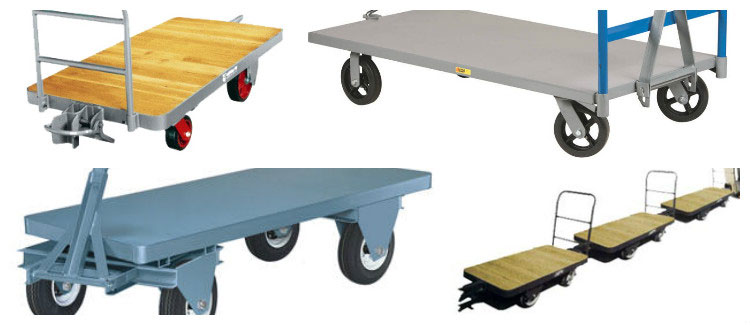
What to Look for When Sizing Up High Capacity Industrial Trailers
Jon Tilmon | 11 January 2017
There are many applications for high capacity industrial trailers in industry today. A couple examples may include handling aluminum slabs, coils, and die handling. Capacities can quickly exceed a hundred thousand pounds or more, and it is essential to match the right trailer components with your warehouse or manufacturing application. Below are 10 things to consider when using industrial trailers for material transport.
1. Walk the ENTIRE flooring path the trailer will travel.
This may include both an interior and exterior travel path which is critical for wheel selection. Look for floor cracks, sloped drain areas, and/or ramps in the travel path. One current example of an application is inclusive of a brick floor and rail road tracks the trailer will have to travel. This is critical knowledge to know to size and select the proper wheels for the application. Improper wheel selection can lead to a costly venture.
2. Consider the available real-estate of your travel path.
Commonly, a large turning radius is required. There are many trailer steer options available to assist in reducing the turning radius; examples include dual steer, quad steer, and fifth wheel steer. Pulling single trailers versus a train of trailers also affects the turning radius.
3. Determine if the trailer will be used in narrow aisles.
If your high-capacity trailer will be used in a facility with narrow aisles, there might not be room to turn around to re-travel the same path. If this occurs, trailer tongues are often used on both ends of the trailers to allow the tugger to travel a path, unhook, re-hook and re-travel a path to eliminate the need to turn around.
4. Will you be pulling a single trailer or a train of trailers?
To handle these types of loads, heavy-duty Caterpillar style tuggers are commonly used. These tuggers have many different styles of trailer hitch points, so it is important to know what you are working with and specific heights of the connection points. Again, specifying the correct trailer tongue height is very important.
5. Will you need a trailer tongue on both ends?
Another item to consider when there is a possibility of pulling a train of trailers is having trailer tongues on both ends. Most often the trailer tongues can be raised to the upright position and locked for travel when not being used.
6. Consider the type of trailer hitch and tongue.
The type of trailer hitch and tongue to be used is also to be considered. Specific trailer hitch examples include hook and eye, spring loaded pin and clevis, safety latch socket and ball, spring loaded jaw and ball, and a pintle style hitch which we have most commonly used. Quite often due to the weight of the trailer tongues, they are spring loaded to assist the users with connections.
7. How should the deck be configured?
You will also need to determine the type of deck for your industrial trailer. Some of the more commonly used options include expanded metal, smooth steel, diamond tread plate, and an open steel frame.
8. Determine your trailer loading needs.
How will the trailer be loaded and unloaded (i.e. workstation crane, fork truck, etc)? Shock loading can raise havoc on all trailer structures and components, decreasing the life expectancy of the trailer. With some planning up front, you can extend the life of your trailer by selecting more durable materials if needed.
9. Are fork pockets required?
If you've determined a fork truck will be used to load or unload your trailer, including fork lift pockets allows you to quickly handle the trailer load in an efficient manner and reduce potential damage.
10. Is there potential for the load to slide or move during travel?
Semi-trailer style tie downs, angle steel welded or bolted around the deck perimeter, and v-cradles welded or bolted to the trailer deck are common solutions to secure or contain a load to the trailer. The best style of containment can be determined by considering the product and how it will be loaded and unloaded. For instance V-cradles are commonly used to secure round stock or coils. With the proper upfront analysis of the work flow, facility layout, and product to be moved; industrial trailers and carts can be used to help improve efficiency and ergonomics throughout your facility. Bastian Solutions welcomes the opportunity to help customers develop the best solution for their material handling needs. Please do not hesitate to contact us for assistance. HAPPY TRAILERING!!
Comments
No comments have been posted to this Blog Post
Leave a Reply
Your email address will not be published.
Comment
Thank you for your comment.